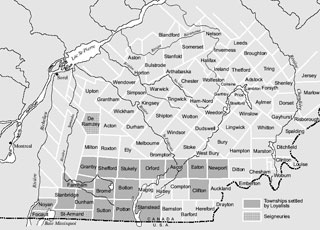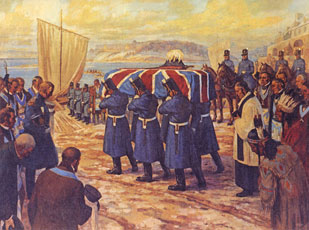Perhaps the greatest contribution of the Loyalists in Quebec was their contribution to the settlement of the Eastern Townships, which began in 1792. It is there that the Loyalists are best remembered, although the majority of the original settlers were not Loyalist.
The story begins during the American
Revolution, where the Loyalists drifted into the Missisquoi Bay area.
The land there was controlled by three English seigneurs. Colonel Henry
Caldwell had purchased what had been the Foucault Seigneurie, which ran
along the Richelieu River and a little over the present day frontier.
Col. Gabriel Christie was seigneur of Noyan, and Thomas Dunn was seigneur
of St-Armand.
The land was good and the Loyalists settled in, prospering by selling their crops at relatively high prices, thanks to the wartime market, on which the demand for food and other necessities of life was high. When the Revolutionary War ended, Haldimand expected them to move westwards with the rest of the Loyalists, and cut off their rations, which the government had been providing. At first they resisted efforts to move them by force, but were permitted to stay by Lt. Gov. Henry Hamilton after Haldimand's return to England.
The status of the Missisquoi Bay Loyalists was resolved when the seigneurs agreed to permit them to stay on their land for a nominal fee. The exact number cannot be ascertained, but a petition they sent to the governor included 378 names. Allowing for a family of five, this could suggest a population of about 1600 or so. The land they settled on, the present-day area of Noyan, Clarenceville and St. Armand, was not part of the Eastern Townships which were not opened to settlement until 1791, but have since been regarded as part of the Townships.
Under the terms of the Constitutional Act of 1791, the Eastern Townships were open to settlement and a land rush followed. Most of the 3,000 or so settlers came from the United States. A few were Loyalist, at least in spirit, but most simply wanted land, and had no strong feeling about nationality.
The Missisquoi Loyalists were in a unique position to play a leading role in this population movement. Perhaps the most conspicuous of them was Gilbert Hyatt, who founded Hyatt's Mills, which later became Sherbrooke, now the metropolis of the Townships.
Loyalist families like the Ruiters were originally from the Palatinate in Germany. In the early years of the 18th century, several thousand German Protestants had left the "Palatinate" area along the Rhine River and took refuge in England, to escape the poverty of their homeland, which had been ravaged by European wars, and because of alleged religious persecution. Many "Palatines" subsequently were sent by the British Government to Ireland and then to America, where most settled in the colony of New York. During the American Revolution, their descendants tended to support the Crown. Henry Ruiter, for example, served as a Loyalist officer, and subsequently became a Justice of the Peace in Quebec. John Ruiter became an officer for the administration of oaths and Jacob Ruiter established a sawmill near Cowansville.
Captain John Savage, born in Ireland, had emigrated to New York, where he was a large landowner near Albany, until the Revolution began. He then became a Loyalist. In Quebec, he first settled on the part of Caldwell Manor that was assigned to Vermont in 1791. He moved again to lead a party of fellow-Loyalists to the Shefford area. There was Henry Bolton, a preacher who helped form Bolton Township; the Baptist Ebenezer Clark, who settled in Stanbridge Township; and the Methodist Samuel Embury. Loyalist founding fathers can be found in most areas of the Townships and families of long residence usually have Loyalist ancestors.
Like the Puritan families in New England, the Loyalists set the tone of the Eastern Townships’ development. Loyalists provided the one positive political idea among the early settlers. So in a sense, the Eastern Townships may be recorded as the outstanding achievement of the Loyalists in the province, and the Loyalist tradition is still preserved in local historical societies, and in Township branches of the United Empire Loyalist Association. Sir John Johnson, perhaps the most eminent of the Loyalists, is buried at Mont Saint-Grégoire (formerly called “Mount Johnson”), not far from the Townships.

